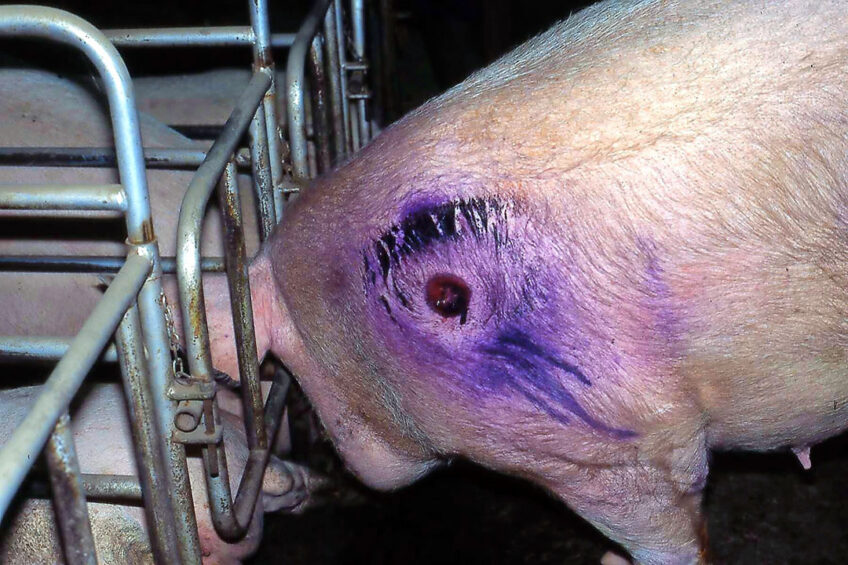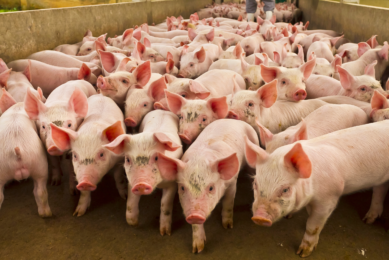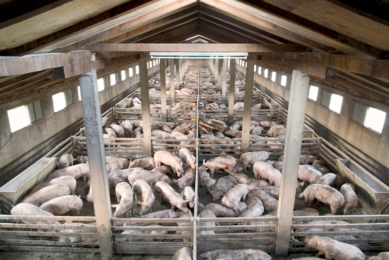A novel sow shoulder sore treatment

Even though zinc oxide at pharmacological levels is on its way out for use in weaner diets in Europe, the substance can have promising applications when used in a completely different way. Researchers tested the use of zinc oxide when treating shoulder sores, writes pig health and welfare expert Dr Monique Pairis-Garcia.
Shoulder sores/ulcers in sows have been a challenging welfare issue for pig producers on a global scale. They are superficial skin lesions that primarily occur over the spine of the scapula. They are more frequently observed in sows housed in confined systems that lack bedding or mats that provide cushions between the sow and the floor.
Shoulder sore prevalence in breeding herds varies, with studies estimating between 8-34% of sows showing some clinical evidence of a lesion. Shoulder sore severity varies as well; some lesions may be restricted to the superficial skin layers, while more severe and chronic sores can influence the dermal skin layer and potentially impact bone.
Poor sow body condition
Sows are more at risk of developing shoulder sores if they have a poor body condition or if they show clinical signs of lameness. Shoulder sore presence has significant welfare implications given the concern surrounding acute and chronic pain associated with the lesion.
Although the industry recognises shoulder sores as a significant welfare issue, producers have struggled to find an effective management option for treating and preventing shoulder sores. Fortunately, thanks to the collaborative work between Iowa State University and Smithfield Foods, a realistic solution appears to be on the horizon.
Realistic shoulder sore treatment option
Dr Anna Johnson, professor in animal behaviour and welfare (Tyron D. Artz Chair for Faculty Excellence in Animal Science) in collaboration with Dr Ashley DeDecker, Dr Mary Batrell, Mrs Mallory Yake-Strickland, MaKayla Sharp, and Devan Avery of the Smithfield Foods research team identified a realistic treatment option for any producer to implement on farm.
In this applied research study conducted in 2020, 2 treatment options were evaluated, including iodine spray and zinc oxide (20% zinc oxide; inactive ingredients: petrolatum, mineral oil). The study evaluated total healing time, scab formation and percentage of enrolled sows removed from the herd. A total of 168 sows per treatment were included and respective treatments were applied once for 14 consecutive days.
Option with positive impact on sow welfare
Results from the study demonstrated that sows treated with zinc oxide had the shoulder sore heal 1 day faster than the iodine spray alone and 12.5% more sows in the zinc oxide treatment developed scabs when compared to iodine. In addition, zinc oxide lowered sow removal by 30% (of sows enrolled on study alone), especially in farms with wet environments, given the zinc oxide’s water resistance and ability to stay applied to the wound for a longer period of time.
Although further research is needed, the results from this study are promising and provide a realistic treatment option for producers to use. This will not only have a positive impact on the welfare of the sow, thus reducing prolonged healing and wound severity, but may also have potential economic benefits to the producer by reducing sow loss on-farm with an economical treatment solution.
The picture with the article was used with permission of the British National Animal Disease Information Service (NADIS).











